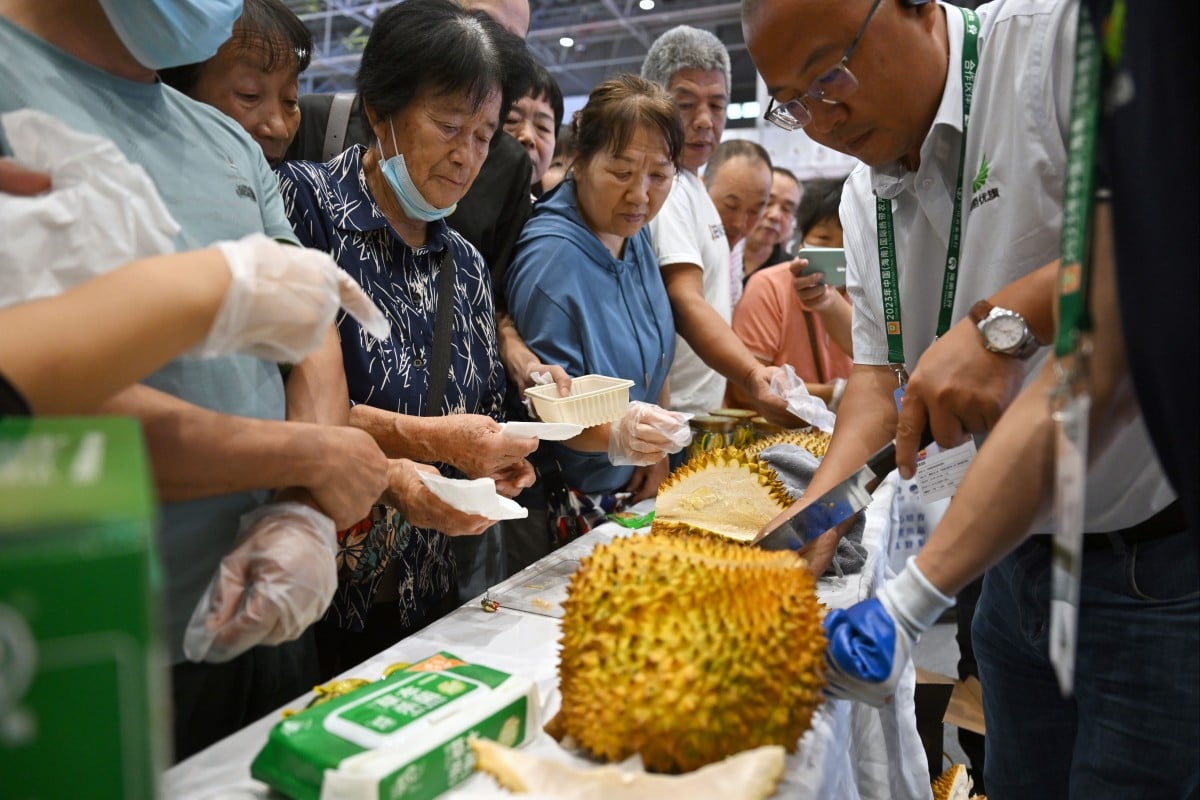USD Analytics, an information and analytics provider based in India, predicted in October last year that the global durian market is expected to grow by 7.51% from 2023 to 2030.
Research and Markets, based in Ireland, forecasted in a report last month that the compound annual growth rate of the global durian market will be 9.77% by 2030.

In China, each durian costs between 100 and 200 Chinese yuan (equivalent to 340,000 to 680,000 VND). Photo: SCMP
The Chinese durian market has room for growth
According to the Food and Agriculture Organization of the United Nations (FAO), China accounts for 95% of global durian consumption.
Zhao Xijun, a finance professor at Renmin University in Beijing, said that the Chinese market has room for development and a diverse supply of durians will help lower prices, which consumers will welcome.
“Currently, prices are quite high so the market is not saturated,” Zhao said, adding that if China receives more imported durians, prices “will definitely decrease.”
Some consumers in China said that durians, which have become so popular that they are called the “king of fruits” in some places, have different qualities depending on each batch. This fruit, famous for its strong aroma, can cost between 100 and 200 Chinese yuan (CNY, equivalent to 340,000 to 680,000 VND) per fruit.
Zhao Yu, a 37-year-old financial expert in Shanghai, pays an average of 28 CNY (96,000 VND) for half a kilogram of durian.
“If durians are sold nearby and at an acceptable price, I will give it a try,” Zhao said. However, in general, she finds the prices not cheap and would like to have more supply sources.
Wang Hui, a 44-year-old woman in Beijing, found the prices of durians to be “high” and the quality unstable. She noticed that prices vary by season and said it would be great to have more supply options from Malaysia or the Philippines.
“If you choose a bad fruit at a high price, it will affect your mood,” Wang said.
Professor Zhao Xijun at Renmin University said that China can easily import more durian shipments from Vietnam, Malaysia, and the Philippines. All three countries are aiming to capture 68% of Thailand’s durian market share in China.
Vietnam accounts for 31.82% of the market share in China
According to the South China Morning Post (SCMP), durians have become a favorite tropical fruit for the middle class in China, sometimes used as a precious gift for newlyweds or to introduce future mothers-in-law.
However, China’s durian production is still low and cannot be compared to the Southeast Asian countries. The supply source, demand, and transportation costs determine the selling price of durians on shelves in China.
According to SCMP, Malaysia, which is currently only allowed to sell frozen durians to China, is aiming for a deal this year to start shipping fresh durians.
The Malaysian Ministry of Agriculture and Agro-based Industry said last year that they could export 22,000 tons of durians to China by 2030, up from only 236 tons in 2018.
According to SCMP, since Vietnam was allowed to export fresh durians to China in 2021, Vietnam accounted for 31.82% of the market share in China last year.
China imported a total of 1.4 million tons of durians in 2023, SMCP reported.

Vietnam’s first official durian shipment to China. Photo: BT
Faye Oguio, a durian expert in Davao City, Philippines, said that in the Philippines, the central government and local authorities are working to expand production from about 1,200 hectares to 3,000 hectares on Mindanao Island in the south. Philippine durians only account for less than 1% of China’s total durian imports in 2023.
Oguio said that the Philippine government is providing seedlings, equipment, and technology to durian farmers. Meanwhile, local authorities are checking if packaging houses there are qualified to transport fresh durians to China.
“The government is making efforts throughout the value chain to take advantage of a very large market… Our current limitations are low productivity. We are still very young in terms of technology and our area is small compared to Malaysia or Thailand,”
Oguio said.
Professor Zhao Xijun said that cities in northern China can consume more imported durians, and the country has not yet expanded into the durian snack and beverage market.
He added that different consumer preferences will open up the market for new types of durians, which means more opportunities for imports from other Southeast Asian countries.
Victor Gao, deputy director of the China and Globalization Center in Beijing, said that the popularity of e-commerce and home delivery in China will increase durian consumption nationwide and help lower prices.
Huu Hien









































